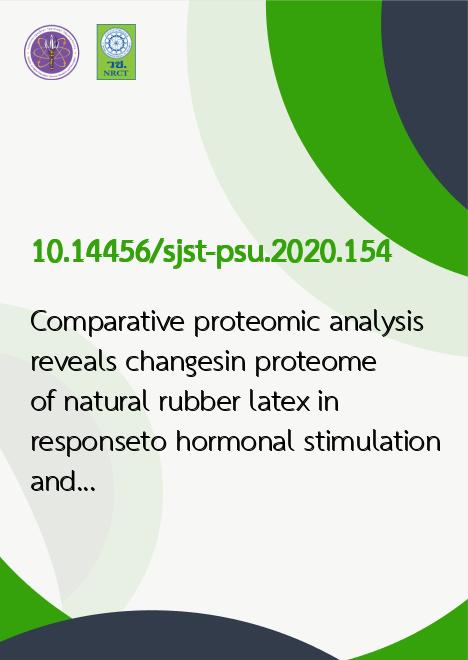
|
Comparative proteomic analysis reveals changesin proteome of natural rubber latex in responseto hormonal stimulation and plant maturation |
|---|---|
| รหัสดีโอไอ | |
| Creator | 1. Waeowalee Choksawangkarn 2. Pairin Daengnoi 3. Rinya Chumkamol 4. Suthathip Kittisenachai 5. Janthima Jaresitthikunchai 6. Sittiruk Roytrakul |
| Title | Comparative proteomic analysis reveals changesin proteome of natural rubber latex in responseto hormonal stimulation and plant maturation |
| Publisher | Research and Development Office, Prince of Songkla University |
| Publication Year | 2563 |
| Journal Title | Songklanakarin Journal of Science and Technology |
| Journal Vol. | 42 |
| Journal No. | 6 |
| Page no. | 1187-1196 |
| Keyword | rubber latex, Hevea brasiliensis, proteomics, ethylene, aging |
| URL Website | https://rdo.psu.ac.th/sjstweb/index.php |
| ISSN | 0125-3395 |
| Abstract | Availability of cis-1,4-polyisoprene from Hevea brasiliensis has become important for many kinds of products, as it isused in automobiles, gloves, and adhesives. Increasing the yield of latex from rubber trees would contribute to income in tropicalcountries. The latex yield depends on various factors, including plant hormones and aging. This work focused on studying theeffects of these factors on dry rubber content and on proteome profiles. The results suggest that dry rubber content slightlydecreased upon hormonal treatment, and increased with maturation. Both factors affected the protein concentration. Comparativeproteomic analysis indicated that ethylene stimulation altered abundances of 1,553 soluble proteins and 1,001 rubber-boundproteins. Plant maturation affected abundances of 2,961 soluble proteins and 839 rubber-bound proteins. These results provideuseful information about the protein-level mechanisms of rubber biosynthesis, affecting rubber yield in response to hormonetreatment and aging. |
